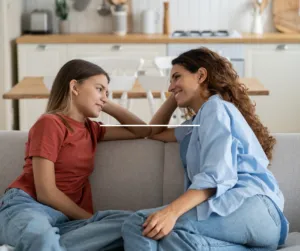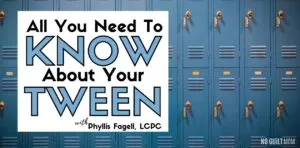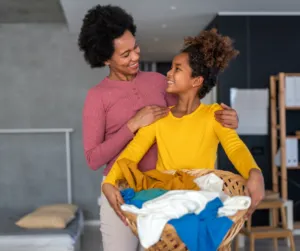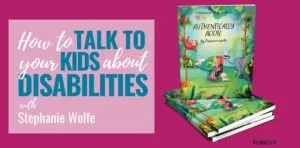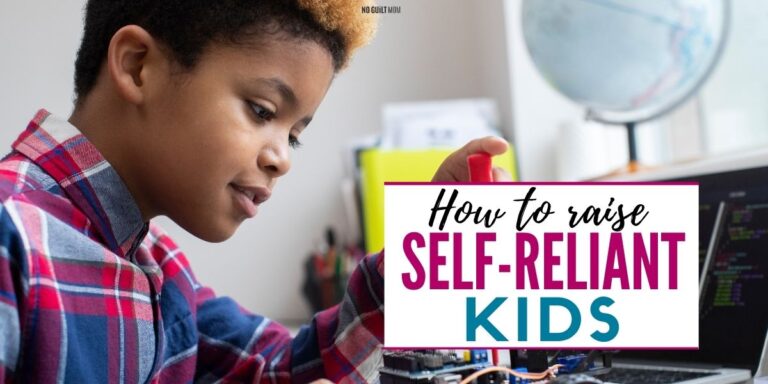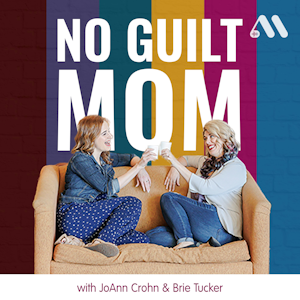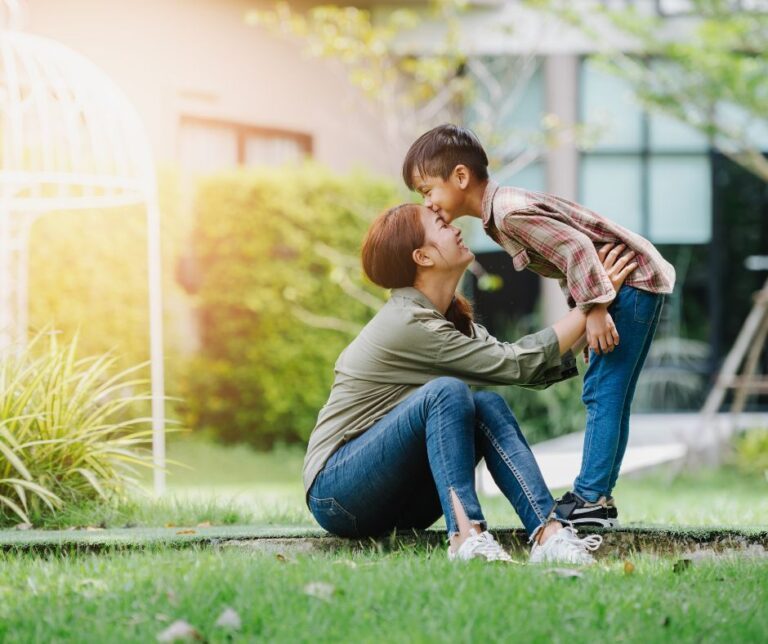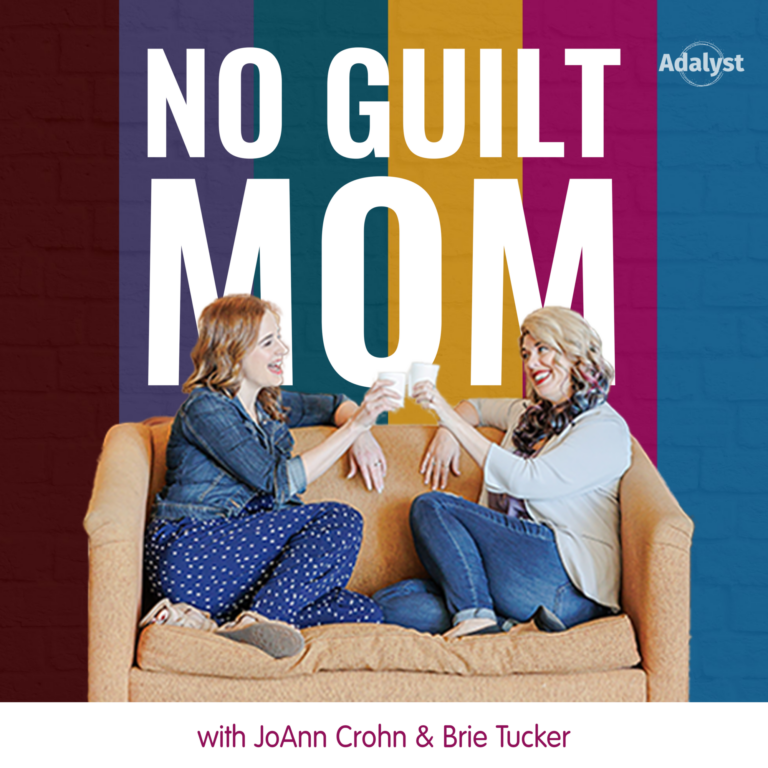[00:00:00] Hey, it’s Joann. Welcome to the no guilt mom podcast. so if you feel like you have a hard time talking to your tween or teen, first of all, know that you’re not alone. And second, you are in the very, very right place, because today we’re going to talk about how to talk to your teen or tween without them tuning you out. And of course, as soon as I heard tuning you out, I was like, we’re going to make this TV theme.
[00:00:27] So for all of you children of the nineties, you’re going to recognize a few references in here.
[00:00:34] And I am. So excited to get started on this topic. I myself am a mother of a 14 year old and a 10 year old. So know that I know the research. I know the theory, but I also live it every day. And I know how hard it is when you try to talk to your teen. or your tween and you get eye rolls and you get push offs and it’s like they don’t want to talk to you and you’re the uncoolest person in the entire world.
[00:01:08] I feel like sometimes I have been transported back to my middle school and high school days when I’m talking to my kids because there’s something in there that just it takes you like it takes you back. And that’s a hard impulse to stop in yourself. So, first of all, know that if you’re experiencing that too, if you’re feeling that rejection from your kids, that’s normal.
[00:01:34] It is just something about our human nature. And that you’re not the only one experiencing it. We, in this entire community, are experiencing it right along with you. But you’re also at the point where, hey, How can I make this communication between me and my child a lot better? Because right now, maybe your child’s not sharing things with you, or they’re refusing to answer your questions, or even refusing to help out at home, and the interactions are just becoming very awkward.
[00:02:09] Now, a common mistake that parents make when they sit down to talk with their teen is that they sit down and talk with their teen. Like did you ever have this happen to you when you were a kid? Your parents like, let’s talk or it’s around the dinner table and you’re eye to eye with them and you just don’t know what to say.
[00:02:27] Like your stress response starts. It’s filling up and all of a sudden you’re scared and you’re fearful. It feels like a confrontation. It feels like you did something wrong. You sense danger. And that’s exactly what our kids sense as well. When we try to sit down and talk with them. It feels dangerous. It feels like they have to be on the defensive.
[00:02:52] It’s exactly how, like, yesterday morning I was in the Starbucks parking lot with my son in the passenger seat and a cop appears at my window. And every time I see a cop at my window, immediately I’m like, uh, I’m in trouble. And you could feel your blood pressure rising. I related a lot to that. Now, the cop was at my window because he saw my son in Starbucks and just wanted to give him a badge.
[00:03:20] Like, a really, really nice gesture. But it’s still, you have those experiences where you’ve been in trouble in the past and that is what you experience and that’s what our kids are experiencing too when we want to sit them down and talk. So it’s not the best way. through the situation. Here is what’s going to work.
[00:03:43] I want you, I want to take you back right now to the 90s where you are getting ready for appointment television and the best appointment television of all was TGIF on Fridays with that full house lineup step by step. I forget what else was there. Perfect Strangers was there for a bit. Family Matters was there for a bit.
[00:04:03] Just the 10 of us was there for a bit, but you had this nice and comfy couch and you sit down on the couch and it’s just, oh, you can spend two hours on that couch watching your TGIF. And you also had to be on the right channel, which was ABC. Whatever your ABC channel was for me, uh, growing up in Tucson, Arizona, ours was channel 9.
[00:04:27] We’re on channel 9 at the right time. Fridays. 7 p. m. for us living in Arizona, and you have to listen to it. You have to follow the character’s journey through the show. Else you’ll have no idea what’s going on. Right? And this was just such a wonderful experience that maybe you experienced with your families.
[00:04:49] I remember I used to watch with my mom, sometimes my dad, but he would get distracted and leave the room and go watch Star Trek. It’s just what he did. Uh, but. Think of this TV show experience, and that is how I want you to think about talking with your teens and your tweens. And we’re going to go through it step by step.
[00:05:10] Ooh, that’s another show that was on TGIF, um, but let’s get started. So first you sit on that couch. And remember how I said that couch was comfy. Your couch is your foundation for your talk with your teenager. Before a conversation even begins, you need to make sure that you have a firm footing in that relationship.
[00:05:33] And when you take these steps of a comfy couch, you are strengthening that foundation. You are making it sure every single time you talk with your teenager, it is going to be the most productive it can be. Now, sometimes it’s not that productive, but we’re going to get into that a little bit later. So the first part of comfy is check in for fun.
[00:05:54] A lot of times teens think like we want something from them. We either want them to do a chore, we want to know how they’re doing in school. school or, uh, we, we want some kind of information, like who are they dating or who do they like? It’s a lot of pressure filled situations. And so I want you just to check in for fun.
[00:06:15] Go into your kid’s bedroom when they’re playing Roblox and just plop down on the bed and be like, Hey! just want to hang out with you. Sometimes I bring a book in there. Sometimes I bring my phone and I’m just hanging out in there when my son is playing or my daughter will be on her bed and she’ll be watching YouTube videos on her phone and I’ll just plop down right beside her and cuddle with her and I’m not asking any information.
[00:06:38] I don’t want anything. All I tell them is I just want to be around you. I just want to cuddle with you. I just want to, you know, love you and that’s it. So, check in for fun is a really easy thing you can do that will lower those expectations of what teens and tweens expect when you approach them. Because you’re just checking in, you’re just hanging out.
[00:07:00] The next part is observe. Now, with the observe step, I am a former elementary school teacher and something that they taught us in our elementary educator. education is kid watching. And what you do in kid watching is you just you watch them. You don’t offer any commentary. You kind of look to see how they react to certain things, what their facial features are like, uh, when they clam up in a conversation, when things might be getting tense.
[00:07:30] I could see this a lot happening at the dinner table. When my daughter’s talking, my son says something. And then my daughter like. gives a face. Now it’s not so much the face my daughter makes, I look at my son and I see how he reacts to it because I know that he is pretty sensitive about his older sister’s reactions.
[00:07:49] All of a sudden he stops talking and then five minutes later He, like, stomps away from the kitchen table. Everybody else is like, what happened there? And I have been kid watching, and I know exactly what happened there. He got offended by something his sister said until he couldn’t stand it anymore, and he left.
[00:08:10] the table. And when we kid watch, when we observe, we take in all of this information that may get missed otherwise. And that information gives us clues on how to approach our kids. For example, I would never dream of approaching my son in that moment that he got offended. He would yell at me. He would be incredibly hurt.
[00:08:35] by any, the accusation his sister just said, it would be a big reaction. So instead. I give them time and I give them space. Same goes with our teens. If you’re seeing your teen look down at the floor, maybe they’re not acting as happy as they usually are, that’s a sign just to step back and observe. Not a sign to ask what’s wrong, but just observe a little more and see if you can get more information.
[00:09:06] This third part of comfy is mistakes and apologizing and this is so, so needed. To build a strong foundation with our kids because we have made mistakes. We have messed up as parents. Every single parent has. Everyone has. Every human has. And when we are able to go to our kids and say, Hey, I’m really sorry I did that.
[00:09:33] I am going to make sure that I keep that in mind in the future not to do. It is building that trust with our kids. This idea that they can trust us with the information that they give us. Um, I get called out a lot by my 14 year old for things that I do. Maybe, you know, this age as well, and you’ll get called out a lot as well.
[00:09:54] And every time she tells me that I did something wrong, I sit with it a little bit and I’m like. I’m sorry. I’m sorry. I shouldn’t have done that. For example, just the other day, uh, my husband and I were talking, and we were kind of, we were giving her a hard time, admittedly. Uh, she, uh, she, and she knew that we were giving her a hard time.
[00:10:16] We were talking that, like, she says that certain things are her ideas when we kind of plant information there, and we were joking about that. And she got, she clammed up and she just left the conversation. And then an hour later when we were in the car, she told me, she’s like, I don’t like you talking about me like I’m not there.
[00:10:34] And she had a valid point. We were totally doing that. And I looked at her and I said, I’m sorry. I shouldn’t have done that. I apologize for that. And when we do that, we know how our kids react to situations and we build that trust a lot, lot stronger and bigger. The F is the finding solutions together, and that has to do with any conflict that you have in your home.
[00:11:02] I have a little freebie for you at the end that helps you more with it, but in terms of household chores, in terms of agreements, of when friends come over, All sorts of problems and conflicts, instead of it being you dictating from above that this is the way it’s going to be, I invite you to ask your kids to give feedback.
[00:11:24] And this is not saying that you are giving up your parental control or that they are the bosses of your house. This is just asking for feedback, because when we ask our kids what they think of the situation, we… Get their point of view and sometimes we see. A lot of times this happens to me. I see that their point of view is very valid.
[00:11:49] And I would feel the exact same way that they are right now. And I change my tactics a little bit. So if, for example, I tell my daughter, Hey, like, I need these dishes washed before dinner. I could just say that, That’s it. That’s the rule. You need it done. And she would stomp away mad. But instead, I’m saying, Hey, I need these dishes washed before dinner.
[00:12:14] What do you think about that? And she tells me, Well, it’s really hard for me to wash the dishes before dinner because I’m tired when I come home, and I have all this homework, and I’m stressed out. And I say, I hear you. What do you suggest? And she’s like, Can I wash them before I go to bed? And we talk about that and come to an agreement.
[00:12:33] And finding those solutions together is going to help you and your teen or tween get along a lot better. And I have, again, a freebie for you at the end. And then finally, comfy, is yield decisions. Which means that any decisions that your teen or tween can make on their own, let them do it. You don’t have to control it, even if you feel like it’s going to be the wrong decision.
[00:12:59] If they have a certain class they want to take, but you don’t think that they’ll enjoy that class, Yield the decision to them. If they are in charge of signing up for an extracurricular activity and you see they’re going to miss the deadline, yield that decision to them. It is on their plate. It is their responsibility.
[00:13:20] When we do that, we remove the nagging that we have to do, and we also let our kids experience natural consequences of what not following through feels like. In a way that’s very simple. safe at the time and a way that they can come back from so that when they’re adults, they learn from that situation and make sure that it doesn’t happen.
[00:13:40] So make sure your couch is comfy by building that firm foundation. And then here we are on our comfy couch. We have to make sure that we’re on the right channel on the right time, else we are going to miss that TGIF lineup. Bum, bum, bum, bum, bum, bum, bum, you know, you know. You know what that is if you watch TGIF.
[00:14:03] And what I mean by that is that sometimes our teens and tweens, they don’t want to talk. Uh, in terms of brain development, the amygdala, which is the area of our brains that process fear and threats, is so much more developed than the cerebral cortex in teenagers. So much so that often this fear based part of the brain overpowers the logical part of the brain because it is so much stronger at this time.
[00:14:34] So that’s why you see the bigger reactions from teenagers and the things that just don’t make sense. Like you could step back and be like, wait a minute, like you have so much time to do this assignment. Why are you freaking out? And your teen or tween is like, Oh my gosh, everything is burning down and I am so stressed and It’s because their amygdala is like super powered amygdala right now compared to the cerebral cortex, which is the logical one.
[00:15:00] And that’s why it’s going on. And that’s why I say, on the right channel, at the right time. If you see your teen or tween is freaking out, there is no way that you’re getting through that freakout until everything calms down. And the only thing to let that happen is comfort and time. You just have to make sure that they’re at the place to listen to you.
[00:15:20] And if they’re so amped up. they’re not at that place right now. Another thing is that, remember before when I said sitting down and having like a talk can really excite that amygdala and put all that fear right like center so that kids clam up. A way to avoid that is to have conversations in the car, but not just like any time in the car.
[00:15:44] If you have to bring up something important with your teen or tween, Try to do it like two to three minutes before you’re going to arrive at a destination that they know you’re arriving at. So say you do it right before you drop them off at school. They know their route to school. They know how long it’s going to take to get there.
[00:16:01] So that two to three minutes you have to talk about the issue and they know that they have an automatic, bye mom, see you later. So that they’re more willing to be open, they’re more willing to say their feelings and they’re not going to be stuck in the car. So that’s a little trick that I use to talk about tough stuff.
[00:16:18] It works very, very well. This is also why you might find that your teen or tween comes into you, their bedroom at night, like right when you’re about to fall asleep and wants to talk then. It wants to unload everything then because at that time they are in control of the situation. They don’t have to stay there any longer than they want to.
[00:16:40] And usually when my daughter does that, it is me saying, Hey, I’m really tired. I love you. I need to go to bed. So remember on the right channel at the right time. And then finally, when we’re watching a show. We can’t tell the characters to fix their issues. We can’t tell them how to fix their issues. And that’s what I want you to keep in mind when you’re talking with your teen or tween.
[00:17:05] We need to listen instead of fix. We shouldn’t be offering solutions until… Or I would even say like, just don’t offer solutions. Because we… As parents get so much fear that our kids are taking the wrong path or doing the wrong thing. And of course, we have so much experience that we kind of feel what’s going to happen.
[00:17:28] And so we want to tell them about it. But that’s not the best use of our time with our kids. The best use is to make sure that they feel listened, that they feel heard, and that they feel like they’re not alone in this. So instead of asking statements like, What if you did this? Or what if you did this? Go more towards the reflective listening and think of it as your teenager or tween is telling you a story and you are providing the headline.
[00:17:56] So if they tell you this long, drawn out story of this conflict at lunch and friends and now they’re worried that their friend doesn’t like them because of something they said, you then provide that headline. You say, okay, so I see that you’re concerned that so and so. It doesn’t want to talk to you anymore because you said something that you feel is rude.
[00:18:18] That’s the headline. So instead of telling them how to fix that situation, you’re just telling them that you hear the situation. And that’ll let them tell you so much more. And I have to tell you that getting information as a parent is really, really valuable. Um, because then they will also share with you, again, how you messed up.
[00:18:40] And… Uh, my daughter tells me this all the time. Sometimes I tell her, like, stories from my life that were similar. And I do this with the intention of showing her she’s not alone. However, she doesn’t take it this way sometimes. She told me, I feel like you minimize my feelings saying that they’re not that bad because you went through it and you’re still here.
[00:19:02] And I think about it, I’m like, okay. Okay, I could see how she gets that and I apologize. I tell her that wasn’t my intention and I will be more mindful on what I share. So think about listening, not fixing. And there you have it. There is how to have influence over your teens or tweens and how to talk with them and listen to them and so they won’t tune you out.
[00:19:28] You need to have that supportive base with them. You need to be there at the right time for them to talk or Manufacturer time like the car ride if you really need to talk with them about something and then listen without the intention of Fixing now. I have an action step for you I want you to choose one of these things that I said belongs in that comfy couch And I want you to try it out and see how it works.
[00:19:55] Tell me right now like which one are you gonna try? Which one are you going to try today to see how it goes? It may not be perfect. It won’t be perfect. We’re not perfect as parents and we’re going to make mistakes. But the only thing we could do is try and we just keep moving forward. I told you I had something for you and that is how to get your teen or teen to help out.
[00:20:24] It is all about that F step in Comfy, finding solutions together regarding Helping out around the house and this guide walks you through our happy process, which is having priorities. So which problems you want to tackle first, appreciating your kid’s point of view. That’s the listening without the fixing, processing your own emotions, which is saying how you feel and then problem solving together.
[00:20:51] And finally. Yielding the work and letting them do it. And I give you tons of tips on how to handle a variety of situations and what to say. And you can download that at no guilt mom. com forward slash help dash out. I am so excited that I got to spend this time with you and remember the best mom’s a happy mom.[00:21:15] Take care of you and I’ll talk to you later.

